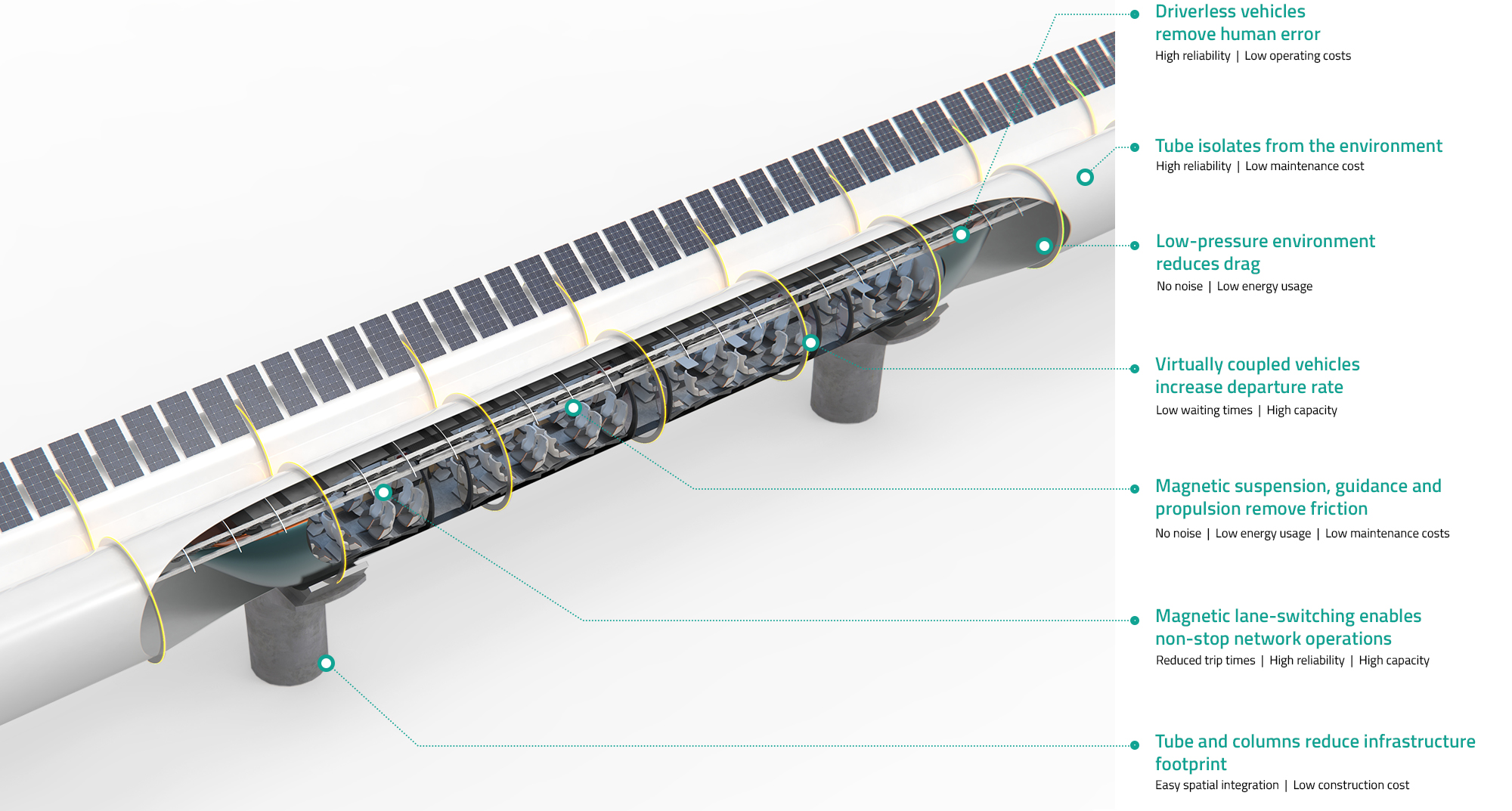The next mode of high-speed, clean transport for large volumes of passengers and cargo

In the hyperloop, autonomous vehicles travel through a network of low-pressure tubes. Vehicles are propelled, suspended, and guided magnetically. It is 10x more energy-efficient than road transport and aviation, uses 2-3x less space needed than rail and road, and provides shorter travel times than aviation.

Passengers can expect short access times at the stations on top of the short trips that hyperloop can provide. Cargo operators can expect highly reliable and traceable service, in combination with efficient loading and unloading of cargo. Throughout the hyperloop infrastructure, there are multiple access points, including passenger stations, cargo stations, and emergency access stations. The latter ensures passenger safety in case of emergency.
System specifications | Value |
Top speed | 1000 km/h |
Cruise speed | 700 km/h |
Transport capacity (700 km/h) | 20,000 Pax/hr/dir (potentially increased platooning) |
Tube diameter | 3.5 m |
Vehicle capacity | Up to 60 passengers |
Power consumption | 35 Wh/pax/km |
Longitudinal acceleration | 0.15 g (average), 0.2 g (peak) |
Vertical acceleration | 0.06 (crest), 0.12 g (through) |
Lateral acceleration | 0.15 g |
Max. Longitudinal jerk | 0.1 g/s |
Max Lateral/vertical jerk | 0.05 g/s |
Corner acceleration | 0.5 g (made possible by 19° banking with 0.15 g max lateral acceleration on pax) |
Min. Corner radius | 200 m |
Headway (700km/h) | 11 sec |
Maximum slope | 10 % |
Right of way | 8 m width |
Turnaround time | 3 minutes |
Emergency brake deceleration | Up to 1.2 g |
Electromagnetic suspension
Our system uses both 'permanent magnets' - magnets with a permanent magnetic field - and electromagnets. The permanent magnets provide enough force to lift the vehicle up without using any energy, and the electromagnets only stabilize the vehicle. As a result, the suspension system uses virtually no energy, being able to lift the weight of a car using the same power as a light bulb.
The vehicle is suspended 15 mm from a steel track, making the infrastructure economical in comparison to other methods of magnetic levitation.
Electromagnetic propulsion
The propulsion system pushes the vehicle forward using only electric energy by means of a linear electric engine, similar to that of an electric car. In the hyperloop, the motor extends across the entire track. This, in combination with electromagnetic suspension, allows the vehicles to propel forward, like surfing a magnetic wave.
After the electric motor propels the vehicle to its cruise speed, it only requires a fraction of the energy to maintain it. When it approaches a station and begins braking, the same system is used to
recover a significant amount of energy, which will either be used to propel the next vehicle, or stored into a battery.
The hyperloop switch
The hyperloop switch allows the vehicle to pass from one track to another, creating a network of tubes where you can go from any origin to any destination.
What makes the hyperloop switch special is that it doesn't have any moving components in the infrastructure. It's the vehicle that either pulls itself to the left or the right track. This allows vehicles to merge out and into the network at high succession, much like a highway.
Low-pressure environment
The high speeds are possible due to the combination of levitation and an environment in which there is no air resistance. This environment is created with vacuum pumps that remove most of the air from the tube to a pressure of 100 Pa, or 0.1% of atmospheric pressure. A pump station the size of a container is needed every few kilometers.
The energy used for traveling with the hyperloop is 10x lower than for road transport or aviation, including the energy to pump down the tubes.
